
Housing Sheep: What You Need To Know
When it comes to housing sheep, there is far more to it than simply hay and fields. There are many legal sheep housing requirements you should adhere to to ensure your sheep remain happy, healthy, and well-sheltered, particularly when temperatures fall. In this article, we will discuss the regulations surrounding keeping sheep, as well as sheep and goat housing, and the things you can do to ensure you meet the needs of your flock faultlessly.
The Code Of Recommendations
The Code Of Recommendations for sheep is a series of clearly outlined regulations that covers the requirements which need to be met to ensure the highest quality of life for your flock. To thrive, you should provide your sheep with five basic freedoms. These freedoms include access to fresh water and a nutritious diet, adequate shelter, fast diagnosis and treatment of health issues, sufficient space, and the prevention of mental suffering.
Sheep housing requirements fall under these freedoms, concerning adequate shelter and sufficient space. The amount of space considered minimal for your sheep will depend on several factors, including the size of your flock, the breed of sheep you raise, and the number of pregnant ewes you are likely to harbour each year.
Pregnancy
It is vital to provide your ewes with as much space as possible while pregnant, and in the months after with their lambs. When it comes to ewes of any breed, the sheep housing requirements state they should be provided 1-1.4 square metres of floor space during pregnancy. Lowland ewes should be given 2-2.2 square metres with their lambs up to six weeks old, and Hill ewes should be given 1.8-2 square metres. Furthermore, lambs up to twelve weeks old should have 0.5-0.6 square metres of floor space of their own, and those from 12 weeks to 12 months should have 0.75-0.9 metres.
Housing sheep while adhering to these requirements will ensure your sheep are happy, healthy, and don’t feel overcrowded. Furthermore, pregnant ewes should not be kept in groups of more than 50 at a time.
Housing
An integral aspect of housing sheep is ensuring they’re offered enough space to rest outdoors that is sheltered from the elements. Not only will your sheep remain dry, but they can access a source of warmth, also. Suitable bedding options include straw, woodchip, and sawdust. Sheep and goat housing should include adequate ventilation without creating draughts, trough space, and lying areas for sleep. The solid floor must be well-drained, and the material used for the floor should be designed to prevent discomfort and injury.
Shelters that meet these sheep housing requirements should be erected throughout your fields to ensure your sheep can easily access suitable shelter at all times, especially when the temperature is particularly cold or hot.
Kit Buildings
Here at Kit Buildings, we have extensive experience in providing agricultural housing for various purposes, including workshops, hay barns, poultry, and livestock buildings. We ensure only the highest quality for our buildings and work closely with our clients to realise their visions and create the farm they want. If you’re interested in finding out more about our farm buildings and what Kit Buildings can do for you, contact us now!

